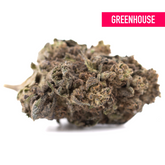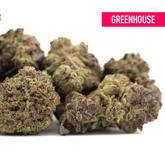How Are New THCA Strains Created? A Complete Guide to Cannabis Breeding

The cannabis industry is experiencing an unprecedented boom in new THCA strains 2025, with breeders and cultivators racing to develop the next generation of high-potency, legally compliant cannabis products. From boutique craft cultivators to large-scale operations, the science of THCA strain breeding has become one of the most exciting and rapidly evolving areas of cannabis agriculture.
But what exactly goes into creating these sought-after strains? How do breeders develop cannabis plants that produce exceptional levels of tetrahydrocannabinolic acid (THCA) while maintaining the complex terpene profiles and effects that consumers crave?
Before diving into the intricate world of cannabis breeding techniques, it's essential to understand the fundamental difference between THCA and THC. THCA is the raw, acidic precursor to THC that exists in living cannabis plants. In its natural state, THCA is non-intoxicating and doesn't produce the psychoactive effects associated with THC. However, when exposed to heat through smoking, vaping, or cooking (a process called decarboxylation), THCA converts to THC, releasing its full psychoactive potential.
This chemical distinction has created a unique legal opportunity. Because THCA technically isn't THC until it's heated, THCA flower exists in a gray area of federal law, particularly when derived from hemp plants containing less than 0.3% delta-9 THC on a dry weight basis. This legal nuance has sparked massive interest in legal THCA strain creation, with breeders working tirelessly to maximize THCA content while staying within regulatory boundaries.
In this comprehensive guide, you'll learn everything about how to create THCA strains, from the initial selection of parent genetics to the final stabilization and testing of new cultivars. We'll explore the science behind THCA cannabis genetics, the practical steps of the THCA breeding process, and the factors that influence high THCA strain development. Whether you're an aspiring breeder, a curious consumer, or a cultivation professional, this guide will illuminate the fascinating journey from seed to shelf-ready strain.
Understanding how new strains are created matters for consumers because it directly impacts the quality, consistency, and effects of the products they purchase. Each new strain represents years of careful selection, testing, and refinement—a testament to both the art and science of modern cannabis cultivation.
Understanding THCA Genetics: The Foundation of Breeding
At the molecular level, THCA cannabinoid profile development begins with understanding how cannabis plants produce cannabinoids. THCA is synthesized in the trichomes—the microscopic, mushroom-shaped glands that cover cannabis flowers and leaves. Within these trichomes, specialized enzymes called THCA synthase convert cannabigerolic acid (CBGA), often called the "mother cannabinoid," into THCA.
The production and accumulation of THCA in cannabis plants is primarily controlled by genetics, though environmental factors also play a significant role. THCA cannabis genetics determine how much THCA synthase a plant produces, which directly correlates to the potential THCA content in the final flower.
Cannabis genetics work similarly to other organisms, with traits passed from parent plants to offspring. Each plant carries genetic information in the form of DNA, which contains instructions for everything from plant structure to cannabinoid production. When breeding high potency THCA strains, breeders are essentially selecting for genetic variations that code for increased THCA synthase production and optimal trichome development.
In cannabis breeding, understanding dominant versus recessive traits is crucial. A dominant trait only needs one copy of a gene to express itself, while a recessive trait requires two copies. THCA production capacity appears to be influenced by multiple genes (polygenic inheritance), making it more complex than simple Mendelian genetics might suggest. This is why stabilizing THCA genetics requires multiple generations of selective breeding—breeders must work to isolate and reinforce the genetic combinations that produce consistently high THCA levels.
The concept of THCA flower genetics extends beyond just cannabinoid content. Breeders must also consider terpene production genes, growth characteristics, disease resistance, flowering time, and yield potential. A strain might produce exceptional THCA levels but be impractical to grow commercially if it's prone to disease or produces minimal yields. The most successful THCA breeding programs balance multiple desirable traits to create commercially viable cultivars.
One fascinating aspect of THCA vs THC breeding is that breeders aren't actually trying to create THC in the plant—they're maximizing THCA production with the knowledge that heat will convert it to THC during consumption. This is distinctly different from decades past when breeders simply focused on "THC content" without distinguishing between the acidic and neutral forms of the cannabinoid.
The genetic variability within cannabis is enormous, which is both a blessing and a challenge for breeders. Cannabis sativa L. has been cultivated and bred for thousands of years across diverse climates and cultures, resulting in a vast gene pool with tremendous potential for creating unique combinations of traits.
The Breeding Process Step-by-Step: Creating New THCA Strains
How to create THCA strains involves a methodical, multi-year process that requires patience, attention to detail, and a solid understanding of plant genetics. Let's break down the THCA breeding process into its essential steps.
Step 1: Selecting Parent Plants
The foundation of successful high THCA strain development begins with parent selection. This is arguably the most critical decision in the entire breeding process, as the genetic qualities of the parents will directly influence all offspring.
When selecting a mother plant (the female that will produce seeds), breeders look for specimens that exhibit:
- Exceptional THCA production: Laboratory testing should confirm high THCA percentages, typically 20% or higher for competitive modern genetics
- Desirable terpene profiles: The aromatic compounds that contribute to flavor, aroma, and effects
- Robust growth characteristics: Vigor, disease resistance, and manageable structure
- Consistent expression: The plant should reliably produce the desired traits across multiple growth cycles
- Appealing flower structure: Dense, resinous buds with good bag appeal
Father plant (male) selection is equally important but often overlooked by novice breeders. While males don't produce the cannabinoid-rich flowers that females do, they contribute 50% of the genetic material to offspring. Quality male selection criteria include:
- Breeding history: Males from proven genetic lines with high THCA offspring
- Structural integrity: Strong stems, healthy growth, and disease resistance
- Terpene production: Yes, males produce terpenes too, which can influence offspring
- Flowering time: Should complement the female's flowering period
- Potency testing of siblings: If the male's sisters produced high THCA, there's a good chance the male carries those genes
Many professional breeders maintain "stud males" that have proven themselves through progeny testing—evaluating the quality of their offspring across multiple breeding projects.
Step 2: Controlled Pollination Methods
Once parent plants are selected, controlled pollination must occur in an isolated environment to prevent contamination from unwanted pollen sources. Professional breeding facilities use separate rooms or even separate buildings to ensure genetic purity.
Cannabis breeding techniques for pollination include:
Selective branch pollination: Applying pollen to specific branches using a small brush while leaving other branches unpollinated. This allows breeders to create multiple crosses on a single mother plant.
Isolation chamber method: Placing the female plant in a completely isolated space and introducing the male or collected pollen in a controlled environment.
Pollen collection and storage: Harvesting male pollen, storing it in cool, dry conditions, and applying it to females at the optimal time. Pollen can be stored for weeks or even months when properly handled.
Timing is critical. Female flowers must be receptive (showing white pistils) and males must be actively releasing pollen. The window for successful pollination typically occurs 2-4 weeks into the flowering phase.
Step 3: Seed Collection and Germination
After successful pollination, seeds develop over the following 4-6 weeks. Mature seeds are dark brown or tan with tiger-stripe patterns and will feel firm when gently pressed. Immature seeds appear green or pale and are not viable.
Seeds should be dried slowly in a cool, dark environment (60-70°F) with moderate humidity (45-55%) for 2-4 weeks before storage or germination. Proper drying prevents mold and ensures genetic stability.
For legal THCA strain creation projects, meticulous record-keeping begins at the seed collection stage. Each cross should be carefully labeled with:
- Parent plant identifiers
- Pollination date
- Harvest date
- Number of seeds collected
- Storage location and conditions
Step 4: Growing Out Offspring (F1 Generation)
The F1 (first filial) generation represents the initial offspring from the parent cross. This generation typically shows hybrid vigor—increased growth rate, yield, and overall health compared to the parents.
However, F1 plants also exhibit considerable variability in cannabis phenotype selection. This genetic diversity is actually desirable at this stage, as it provides the breeder with a range of expressions to evaluate and select from.
Breeders typically grow out 20-100 F1 plants (or more for large-scale breeding programs) to assess the range of traits present in the offspring. This population size provides enough genetic diversity to identify exceptional individuals while remaining manageable.
Step 5: Phenotype Selection and Testing
Cannabis phenotype selection is where the breeder's eye and experience become invaluable. A phenotype is the physical expression of a plant's genetics—how it actually grows, smells, and produces cannabinoids in real-world conditions.
During the F1 evaluation, breeders observe and document:
- Growth patterns and structure
- Flowering time
- Terpene profiles (smell and taste)
- Flower density and resin production
- Pest and disease resistance
- Yield potential
The most promising phenotypes undergo laboratory testing using THCA testing methods to confirm cannabinoid content. This is where many breeders are surprised—a plant that looks incredible may test below expectations, while an unassuming specimen might produce exceptional THCA levels.
Only the top-performing plants (typically 5-10% of the population) move forward to the next generation. These elite phenotypes become the new parents for creating the F2 generation.
Step 6: Stabilization Through Multiple Generations
Stabilizing THCA genetics requires breeding the selected F1 plants together or backcrossing them to one of the original parents. This process continues through F2, F3, F4, and sometimes F5 or beyond until the strain "breeds true"—meaning offspring consistently express the desired traits.
Each generation requires:
- Growing out large populations (50-200 plants minimum)
- Rigorous selection and testing
- Culling of plants that don't meet standards
- Detailed record-keeping of breeding decisions
The F2 generation typically shows the greatest variability as recessive genes recombine in new ways. By F3 and F4, traits begin stabilizing, and by F5 or F6, the strain should produce relatively uniform offspring that reliably express high THCA content and other desired characteristics.
This is why professional THCA strains command premium prices—they represent years of dedicated breeding work to achieve genetic stability and exceptional quality.
Step 7: Final Testing and Naming
Before releasing a new strain, responsible breeders conduct extensive testing across multiple grow cycles and environments. This ensures the genetics perform consistently whether grown indoors, in greenhouses, or outdoors.
Final testing includes:
- Multiple THCA and cannabinoid profile tests from different grows
- Terpene analysis to confirm flavor and aroma consistency
- Stability testing (growing multiple generations to ensure traits hold)
- Cultivation trials in different conditions
- Consumer feedback and effect profiling
Once a strain passes all tests and proves market-worthy, it receives its name—often reflecting its lineage, effects, appearance, or flavor profile. The naming process is both creative and strategic, as the right name can significantly impact consumer interest.

Key Factors in THCA Strain Development
While genetics provide the blueprint, environmental factors dramatically influence how those genetics express themselves. Understanding these variables is essential for breeding high potency THCA cultivars.
Environmental Factors That Influence THCA Production
Cannabis plants are remarkably responsive to their environment, and THCA cannabinoid profile can vary significantly based on growing conditions:
Stress response: Moderate environmental stress (not extreme stress that damages plants) can actually increase cannabinoid production as a natural defense mechanism. This includes controlled drought stress, temperature fluctuations within tolerance ranges, and appropriate light stress.
Growing medium: Soil composition, whether organic soil, coco coir, or hydroponic solutions, affects nutrient uptake and plant metabolism, which in turn influences cannabinoid production.
Air circulation and CO2: Proper airflow prevents mold and disease while promoting healthy growth. Enhanced CO2 levels (up to 1500 ppm) during flowering can increase photosynthesis and potentially boost THCA production.
Nutrient Requirements for Optimal Cannabinoid Development
Cannabinoid production requires specific nutrients at different growth stages:
Flowering phase nutrients: During flowering, when THCA production peaks, plants need:
- Increased phosphorus (P) for flower development
- Appropriate potassium (K) for overall plant health
- Reduced nitrogen (N) compared to vegetative growth
- Micronutrients including sulfur, which supports terpene and cannabinoid production
Nutrient timing: Many breeders use a "flush" period before harvest, giving plants only pure water for the final 1-2 weeks. This forces the plant to consume stored nutrients, potentially improving flavor and promoting last-minute cannabinoid production.
Light Spectrum and THCA Expression
Light is perhaps the most influential environmental factor in cannabis cultivation:
UV light exposure: Research suggests that UV-B light may increase trichome production as a protective mechanism, potentially elevating THCA content. Some breeders supplement with UV-B lighting during late flowering.
Light intensity: Higher light intensity (measured in PPFD—photosynthetic photon flux density) generally correlates with increased cannabinoid production, up to the plant's tolerance threshold.
Light spectrum: Full-spectrum LED lights that mimic natural sunlight, particularly with enhanced red spectrum (620-660nm) during flowering, have been shown to promote robust flower development and cannabinoid synthesis.
Temperature and Humidity Considerations
Temperature ranges: Cannabis plants produce THCA optimally within specific temperature ranges:
- Vegetative growth: 70-85°F (21-29°C)
- Flowering: 65-80°F (18-26°C)
- Late flowering: Slightly cooler temperatures (65-75°F) may preserve terpenes and promote resin production
Humidity control:
- Vegetative stage: 60-70% relative humidity
- Early flowering: 50-60% RH
- Late flowering: 40-50% RH
- Final weeks: 35-45% RH to promote resin production and prevent mold
Harvest Timing for Maximum THCA Content
The harvest window dramatically affects final THCA levels. THCA testing methods have revealed that cannabinoid content changes rapidly during the final weeks of flowering:
Trichome observation: Using a microscope to examine trichomes remains the gold standard. Peak THCA typically occurs when:
- 70-90% of trichomes have turned from clear to milky/cloudy white
- 10-30% of trichomes show amber coloration
- Pistils are 60-80% brown/orange
Early harvest: Results in lower overall THCA content and more "heady," energetic effects
Peak harvest: Maximizes THCA content with balanced effects
Late harvest: THCA begins degrading to CBN (cannabinol), producing more sedative, body-focused effects
Professional breeders test multiple harvest windows on the same genetics to determine the optimal harvest timing for maximum THCA expression.
Testing and Verification: Ensuring Quality and Compliance
No THCA breeding process is complete without rigorous testing. Laboratory analysis serves multiple purposes: verifying cannabinoid content, ensuring regulatory compliance, and providing valuable feedback for breeding decisions.
Laboratory Testing Methods
Two primary methods dominate cannabis testing:
High-Performance Liquid Chromatography (HPLC): This method analyzes cannabis samples without applying heat, providing accurate measurements of THCA in its acidic form. HPLC is considered the gold standard for THCA flower testing because it doesn't cause decarboxylation during analysis.
Gas Chromatography-Mass Spectrometry (GC-MS): This method heats the sample during analysis, converting THCA to THC. While still useful, it provides "total THC" rather than distinguishing between THCA and delta-9 THC, making it less ideal for legal THCA strain creation where the distinction is legally significant.
Modern cannabis testing also includes:
- Full cannabinoid profiles: Measuring THCA, CBD, CBG, CBC, CBN, and other cannabinoids
- Terpene analysis: Identifying and quantifying the aromatic compounds that contribute to effects and flavor
- Contaminant screening: Testing for pesticides, heavy metals, mold, and other harmful substances
What Lab Results Tell Breeders
Laboratory reports provide crucial data for breeding decisions:
Cannabinoid ratios: The relationship between THCA and other cannabinoids helps breeders understand the genetic profile. For example, a strain with 25% THCA and 0.5% CBD tells a different story than one with 20% THCA and 5% CBD.
Consistency across samples: Testing multiple plants from the same cross reveals genetic stability. High variance indicates the strain needs more stabilization work.
Terpene profiles: Dominant terpenes (myrcene, limonene, caryophyllene, etc.) contribute to the strain's unique character. Breeders select for specific terpene combinations that complement high THCA content.
Minimum THCA Percentages for Commercial Viability
The modern cannabis market has become increasingly competitive, with consumers expecting premium potency. For new THCA strains 2025, commercial success typically requires:
- Entry-level: 15-20% THCA (acceptable but not competitive)
- Market standard: 20-25% THCA (expected by most consumers)
- Premium: 25-30% THCA (commands higher prices)
- Elite: 30%+ THCA (rare, highly sought-after)
However, potency isn't everything. Many consumers now prioritize terpene profiles, effects, and overall experience over raw THCA numbers. The most successful breeders create well-rounded strains that offer exceptional quality across multiple dimensions.
Terpene Profile Analysis
Terpenes work synergistically with cannabinoids in what's called the "entourage effect," potentially modifying and enhancing cannabis effects. Common terpenes in high-THCA strains include:
Myrcene: Earthy, musky aroma; potentially relaxing effects
Limonene: Citrus aroma; potentially mood-elevating
Caryophyllene: Spicy, peppery aroma; interacts with CB2 receptors
Pinene: Pine aroma; potentially alerting and memory-enhancing
Linalool: Floral, lavender aroma; potentially calming
Breeders increasingly select for specific terpene profiles to create predictable effects and unique flavor experiences that distinguish their strains in the crowded THCA flower market.
Time and Resources Required: The Reality of Breeding
Creating stable, high-quality THCA strains requires significant investment in time, space, and capital. Understanding these requirements helps explain why premium genetics command premium prices.
Average Timeline for Stable Genetics
The THCA breeding process operates on a multi-year timeline:
Year 1: Parent selection, initial crosses, F1 seed production (6-12 months)
Year 2: F1 grow-out, selection, testing, F2 seed production (12-18 months)
Year 3: F2 stabilization work, continued selection, F3 production (12-18 months)
Year 4-5: Further stabilization (F4, F5), final testing, market preparation (12-24 months)
Realistically, developing truly stable, commercially viable genetics that consistently express high THCA takes 2-5 years minimum, with many professional breeders spending 5-7 years perfecting a single strain.
Cannabis breeding can't be rushed. Each generation requires a complete growth cycle (3-5 months from seed to harvest), plus time for testing, analysis, and decision-making. Unlike annual crops that can be tested once per year in fields, cannabis breeders can run 2-3 generations per year in controlled environments, but this still requires patience and dedication.
Equipment and Space Requirements
Professional high THCA strain development requires substantial infrastructure:
Growing space:
- Dedicated mother plant rooms (maintained in vegetative growth)
- Flowering rooms for evaluation and seed production
- Isolation areas for controlled pollination
- Quarantine areas for testing new genetics
Equipment needs:
- Professional grow lights (LED or HPS systems)
- Climate control (HVAC, dehumidifiers, humidifiers)
- Air filtration and circulation systems
- Irrigation systems
- Microscopes for trichome examination
- Laboratory equipment or testing lab relationships
Minimum space: Small-scale breeding can start in 200-500 square feet, but serious programs typically require 1,000-5,000 square feet or more to grow adequate population sizes.
Cost Considerations
The financial investment in cannabis breeding is substantial:
Initial setup: $10,000-$100,000+ depending on scale and technology choices
Ongoing operational costs:
- Electricity: $500-$5,000+ monthly depending on operation size
- Testing: $100-$300 per sample, with hundreds of samples tested over a breeding project
- Labor: Professional breeders' salaries, cultivation staff, administrative support
- Supplies: Seeds, growing medium, nutrients, equipment maintenance
Total project costs: A professional breeding program can easily cost $50,000-$500,000 or more to bring a stable strain to market, explaining why established breeders and seed companies invest so heavily in protecting their genetics.
Legal Requirements and Licensing
Legal THCA strain creation exists in a complex regulatory landscape that varies significantly by jurisdiction:
Federal considerations: Under the 2018 Farm Bill, hemp-derived products (including THCA flower) containing less than 0.3% delta-9 THC on a dry weight basis are federally legal. However, this is based on the delta-9 THC content, not THCA content, creating the legal space for high-THCA hemp products.
State regulations: Each state maintains its own cannabis and hemp laws. Breeders must comply with:
- Cultivation licenses (hemp or cannabis, depending on state classification)
- Testing requirements
- Seed and plant tracking systems
- Security requirements
- Zoning and land-use regulations
Interstate commerce: Hemp products can legally cross state lines under federal law, but state-level restrictions may apply.
Intellectual property: Some breeders seek plant patents or trademarks to protect their genetics, though enforcement in cannabis remains challenging due to federal prohibition's lingering effects.
The regulatory landscape continues evolving, making it essential for breeders to stay informed about current laws and work with legal counsel experienced in cannabis and hemp law.

The Future of THCA Strain Development
The cannabis breeding industry stands at an exciting crossroads. New THCA strains 2025 represent just the beginning of what's possible as breeding science advances and market demands evolve.
Several trends are shaping the future:
Minor cannabinoid breeding: While THCA dominates current interest, breeders are increasingly focusing on other cannabinoids like THCV, CBG, and CBC, creating strains with unique cannabinoid profiles.
Terpene-focused breeding: As consumers become more educated, demand grows for strains with specific terpene profiles rather than just high potency. Expect to see strains marketed primarily for their terpene content and effects.
Autoflowering THCA genetics: Autoflowering plants (which flower based on age rather than light cycle) are being bred for high THCA content, making cultivation easier and faster.
Climate-adapted genetics: Breeders are developing strains specifically adapted to different growing regions, from humid tropical climates to arid desert conditions.
Consistency and standardization: As the industry matures, consumers and regulators increasingly demand consistent, reproducible genetics that perform reliably across different growing environments.
Sustainability focus: Environmental consciousness is driving breeding efforts toward more efficient plants that require less water, nutrients, and energy while producing high THCA content.
The scientific understanding of THCA cannabis genetics continues advancing rapidly. Researchers are mapping the cannabis genome, identifying specific genes responsible for cannabinoid and terpene production, and developing molecular markers that allow breeders to select for desired traits without growing plants to maturity. These advances will dramatically accelerate breeding timelines and precision in the coming years.
Frequently Asked Questions About THCA Breeding
How long does it take to create a new THCA strain?
Creating a stable, commercially viable THCA strain typically takes 2-5 years of dedicated breeding work, including multiple generations of selection, testing, and stabilization. Some elite strains represent 5-7 years of development.
Can anyone breed THCA strains, or do you need special licensing?
Legal requirements vary by location. In hemp-legal states, you can breed hemp plants (including high-THCA hemp) with proper hemp cultivation licenses. In cannabis-legal states, you'll need appropriate cultivation licenses. Always check your local and state regulations before beginning any breeding program.
What's the difference between breeding for THCA versus THC?
Biologically, there's no difference—you're selecting for THCA production capacity in the plant, knowing it will convert to THC when heated. The legal distinction matters for compliance, but the breeding process focuses on maximizing THCA synthase expression regardless of what the consumer calls it. Learn more about THCA vs THC breeding.
How much does THCA testing cost?
Professional cannabis laboratory testing typically costs $100-$300 per sample, depending on the comprehensiveness of the analysis. Full cannabinoid and terpene profiles cost more than basic potency testing. Breeders may test hundreds of samples throughout a breeding project using various THCA testing methods.
What THCA percentage is considered high?
In today's competitive market, 20-25% THCA is considered standard for quality strains, 25-30% is premium, and anything above 30% is exceptional. However, many factors beyond raw potency contribute to a strain's quality and appeal.
Can you breed THCA strains for specific effects?
Yes, experienced breeders can select for characteristics associated with different effects by choosing parent genetics with specific terpene profiles and cannabinoid ratios. The "entourage effect" suggests that combinations of cannabinoids and terpenes create different experiences, though more research is needed to fully understand these interactions.
Do THCA strains require special growing conditions compared to regular cannabis?
No, high-THCA strains are grown using standard cannabis breeding techniques and cultivation methods. However, optimizing environmental factors like light, nutrients, and harvest timing can maximize THCA expression in any genetic line.
How do breeders keep their genetics stable over time?
Breeders maintain mother plants (clones kept in vegetative growth) of their best phenotypes, ensuring genetic consistency. Seeds are produced from stabilized lines that breed true across multiple generations through the process of stabilizing THCA genetics. Regular testing and observation ensure quality control.
Is it legal to ship THCA flower across state lines?
Under the 2018 Farm Bill, hemp-derived products containing less than 0.3% delta-9 THC can legally be shipped across state lines. However, state laws vary, and some states have banned THCA products. Always verify the legal status in both shipping and receiving states.
What's the most important factor in breeding high-THCA strains?
While many factors contribute, parent selection is arguably most critical. Starting with exceptional genetics that already produce high THCA gives you the foundation for success. From there, careful cannabis phenotype selection, rigorous testing, and patience through multiple generations ensure quality results.
Conclusion: The Art and Science of THCA Breeding
Creating new THCA strains represents a remarkable intersection of art, science, and patience. From the initial selection of parent genetics through years of careful breeding, selection, and testing, each stable strain embodies thousands of hours of dedicated work by skilled cultivators and breeders.
Understanding how to create THCA strains gives consumers appreciation for the premium genetics they purchase. When you explore high-quality THCA flower, you're experiencing the culmination of sophisticated cannabis breeding techniques that balance potency, terpene profiles, effects, and growing characteristics.
The THCA breeding process continues evolving as breeders gain access to better technology, deeper genetic understanding, and clearer market feedback. The new THCA strains 2025 and beyond will benefit from years of accumulated knowledge, molecular breeding tools, and increasingly sophisticated consumer preferences.
For those interested in becoming cannabis breeders, start with education: study plant genetics, intern with established breeding programs, and develop relationships within the cultivation community. For consumers, explore the incredible diversity of THCA strains available today, knowing that each one represents a unique genetic expression crafted through years of THCA strain breeding.
The future of high THCA strain development looks brighter than ever. As legal frameworks stabilize, technology advances, and consumer education improves, we can expect increasingly refined genetics that deliver consistent, exceptional experiences. Whether you're drawn to fruity, citrus-forward cultivars or earthy, gas-heavy indicas, there's never been a better time to explore the diverse world of professionally bred THCA flower genetics.
The next time you enjoy premium THCA flower, take a moment to appreciate the breeding journey that made it possible—from carefully selected parents through multiple generations of refinement using advanced THCA testing methods, all designed to deliver the exceptional experience in your hands.
Ready to experience the results of cutting-edge breeding high potency THCA programs? Explore the finest THCA strains available today and discover the difference that professional genetics make.













